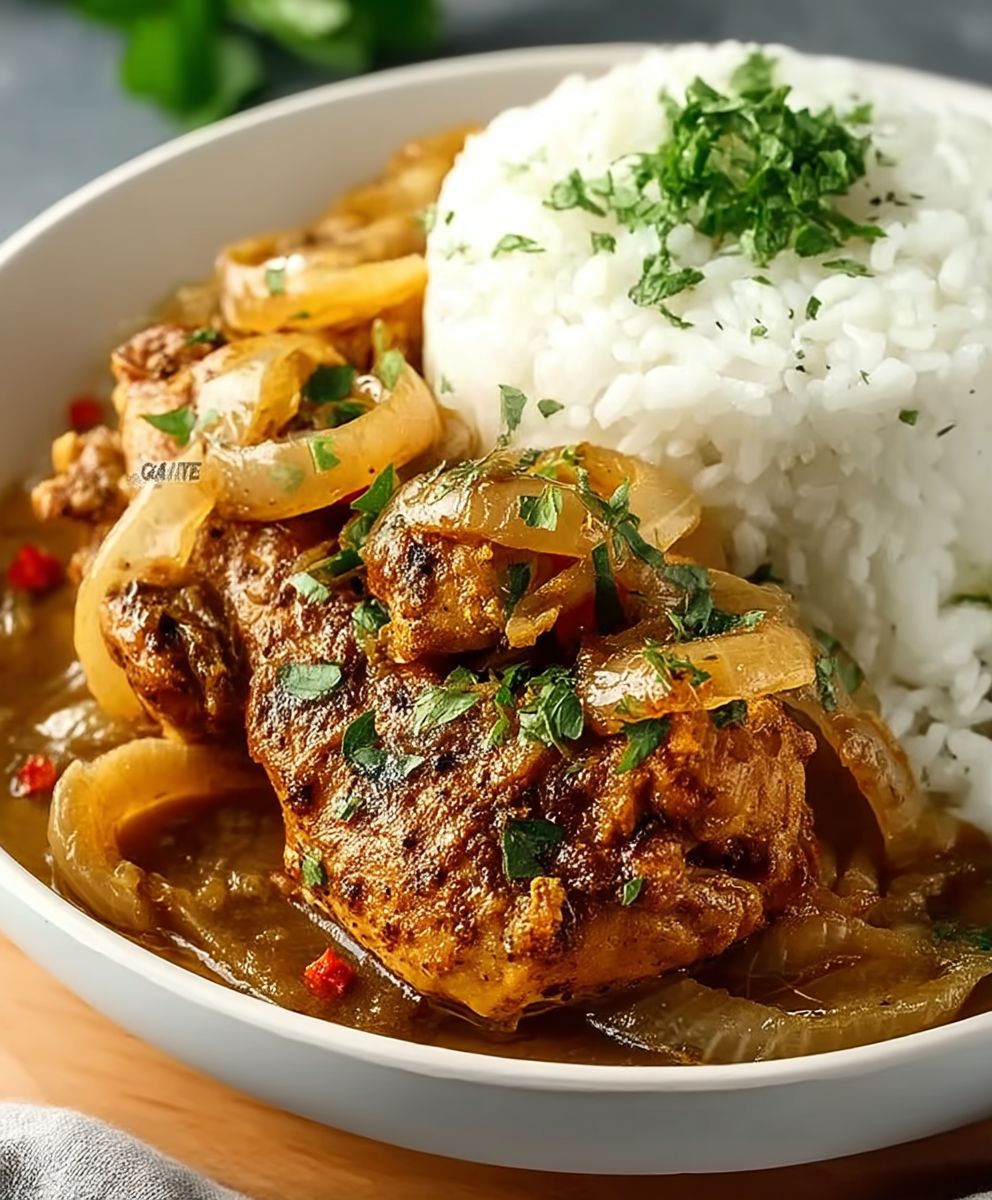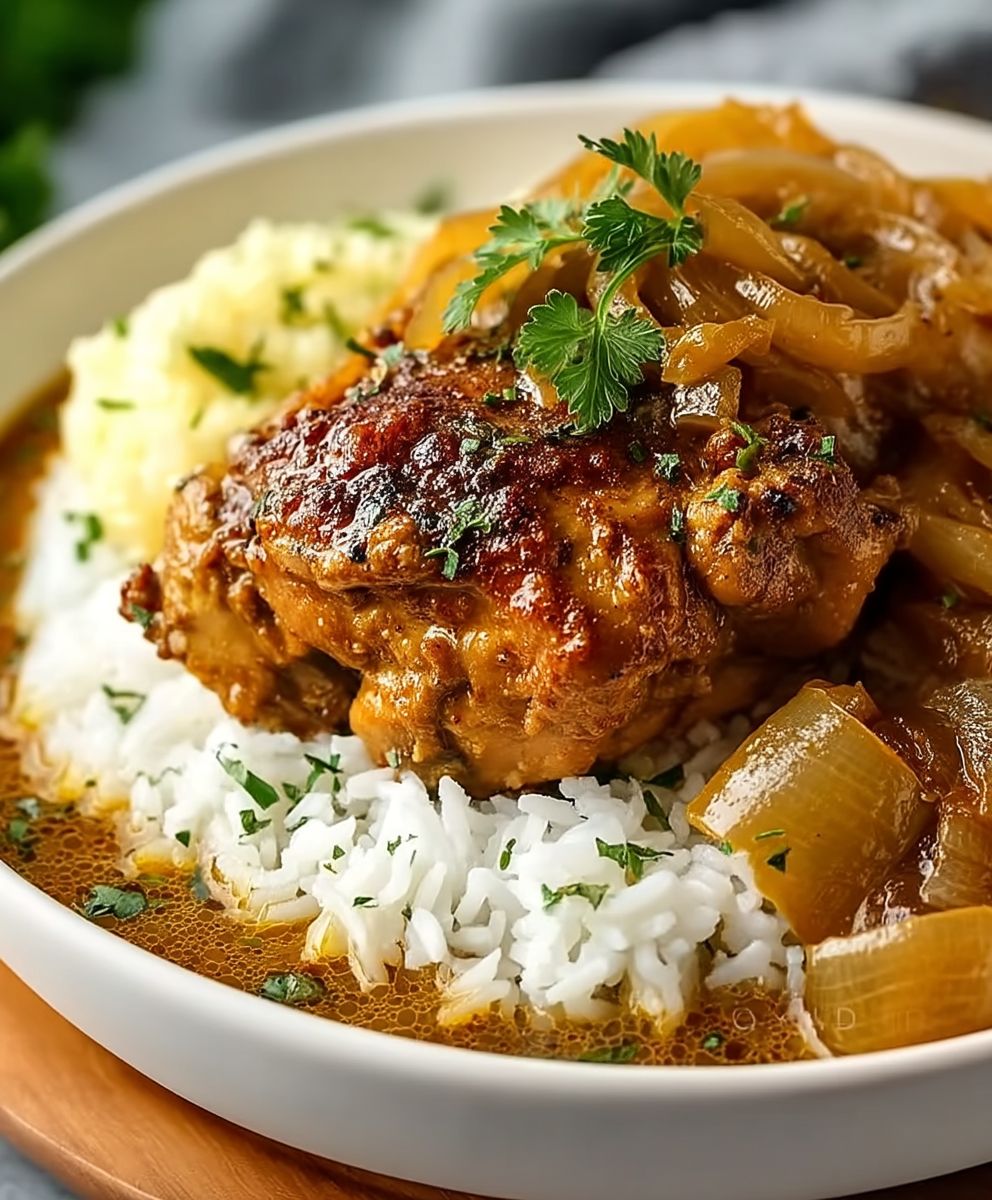Poulet Yassa, a culinary jewel from Senegal, is about to become your new favorite chicken dish! Imagine succulent chicken, marinated in a vibrant lemon and onion sauce, slowly simmered to tender perfection. The aroma alone is enough to transport you to the bustling markets of West Africa.
This isn’t just a recipe; it’s a taste of history. Poulet Yassa, deeply rooted in Senegalese culture, has been passed down through generations, each family adding their own unique touch. It’s a dish often served during celebrations and gatherings, symbolizing warmth, hospitality, and the joy of sharing a delicious meal.
What makes Poulet Yassa so irresistible? It’s the perfect balance of tangy lemon, savory onions, and the rich flavor of perfectly cooked chicken. The slow cooking process ensures that the chicken is incredibly tender and infused with the flavorful sauce. People adore it because it’s both comforting and exciting, a dish that’s easy to prepare yet delivers a complex and satisfying taste experience. Plus, it’s incredibly versatile serve it with rice, couscous, or even roasted vegetables for a complete and unforgettable meal. Get ready to embark on a culinary adventure with this authentic Senegalese delight!
Ingredients:
- Chicken: 2.5-3 lbs chicken, cut into serving pieces (bone-in, skin-on thighs and drumsticks work best)
- Onions: 4 large yellow onions, thinly sliced
- Lemon Juice: 1 cup freshly squeezed lemon juice (about 6-8 lemons)
- Dijon Mustard: 2 tablespoons Dijon mustard
- Garlic: 6 cloves garlic, minced
- Chicken Broth: 1 cup chicken broth (low sodium preferred)
- Olive Oil: 1/4 cup olive oil
- Scotch Bonnet Pepper (or Habanero): 1 small Scotch bonnet pepper, seeded and finely minced (adjust to your spice preference, or omit entirely)
- Thyme: 2 teaspoons dried thyme
- Bay Leaves: 2 bay leaves
- Salt: To taste
- Black Pepper: To taste
- Optional Garnish: Fresh parsley or cilantro, chopped
- Optional: 1 green bell pepper, thinly sliced
- Optional: 1 red bell pepper, thinly sliced
Marinating the Chicken:
This is a crucial step for developing the signature Yassa flavor! Don’t skip it, and the longer you marinate, the better it will taste. I usually aim for at least 4 hours, but overnight is ideal.
- Prepare the Marinade: In a large bowl, whisk together the lemon juice, Dijon mustard, minced garlic, minced Scotch bonnet pepper (if using), thyme, salt, and black pepper. Make sure everything is well combined. Taste the marinade and adjust the seasoning to your liking. Remember that the flavor will intensify as it marinates.
- Marinate the Chicken: Add the chicken pieces to the marinade. Make sure each piece is thoroughly coated. You can use your hands to massage the marinade into the chicken.
- Refrigerate: Cover the bowl tightly with plastic wrap or transfer the chicken and marinade to a resealable plastic bag. Refrigerate for at least 4 hours, or preferably overnight. The longer it marinates, the more flavorful and tender the chicken will become. Turn the chicken occasionally to ensure even marinating.
Cooking the Onions:
The onions are the heart of Poulet Yassa. They need to be cooked down until they are incredibly soft and sweet. This step takes time, so be patient!
- Sauté the Onions: Heat the olive oil in a large, heavy-bottomed pot or Dutch oven over medium heat. Add the sliced onions and cook, stirring frequently, until they begin to soften and turn translucent, about 10-15 minutes.
- Caramelize the Onions: Reduce the heat to low and continue to cook the onions, stirring occasionally, until they are very soft, golden brown, and caramelized. This will take at least 30-45 minutes, possibly longer. The key is to cook them slowly and gently, allowing them to release their natural sugars. If the onions start to stick to the bottom of the pot, add a tablespoon or two of water or chicken broth and scrape up any browned bits.
- Add Optional Bell Peppers: If you’re using bell peppers, add them to the pot with the onions about 15 minutes before the onions are done. This will allow them to soften slightly without becoming mushy.
Cooking the Chicken:
Now it’s time to bring everything together! We’ll sear the chicken to get a nice color and then simmer it in the onion sauce until it’s cooked through and incredibly tender.
- Sear the Chicken (Optional but Recommended): Remove the chicken from the marinade, reserving the marinade. Pat the chicken pieces dry with paper towels. This will help them brown better. In a large skillet (or in batches in the same pot you used for the onions), heat a tablespoon of olive oil over medium-high heat. Sear the chicken pieces on all sides until they are golden brown, about 3-4 minutes per side. This step adds flavor and color to the dish. Remove the chicken from the skillet and set aside.
- Deglaze the Pan (If Searing): If you seared the chicken, deglaze the skillet by adding a splash of chicken broth or water and scraping up any browned bits from the bottom of the pan. Add these flavorful bits to the pot with the onions.
- Combine Chicken and Onions: Add the seared chicken pieces (or the marinated chicken if you skipped the searing step) to the pot with the caramelized onions.
- Add Remaining Ingredients: Pour the reserved marinade and the chicken broth over the chicken and onions. Add the bay leaves.
- Simmer: Bring the mixture to a simmer, then reduce the heat to low, cover the pot, and simmer for 45-60 minutes, or until the chicken is cooked through and very tender. The internal temperature of the chicken should reach 165°F (74°C).
- Check and Adjust Seasoning: After the chicken is cooked, remove the bay leaves. Taste the sauce and adjust the seasoning with salt and pepper as needed. The sauce should be tangy, savory, and slightly spicy (depending on how much Scotch bonnet pepper you used).
- Thicken the Sauce (Optional): If the sauce is too thin, you can remove the chicken pieces from the pot and set them aside. Increase the heat to medium and simmer the sauce, uncovered, until it has thickened to your desired consistency. Be careful not to burn the sauce. Return the chicken to the pot and heat through.
Serving:
Poulet Yassa is traditionally served with white rice, but it’s also delicious with couscous or even potatoes. Don’t forget to spoon plenty of the flavorful onion sauce over the rice!
- Serve Hot: Serve the Poulet Yassa hot, spooning the chicken and onion sauce over a bed of rice, couscous, or potatoes.
- Garnish (Optional): Garnish with fresh chopped parsley or cilantro for a pop of color and freshness.
Tips for Success:
- Don’t be afraid of the lemon juice! The acidity is what gives Poulet Yassa its signature tang.
- Use good quality chicken. The better the chicken, the better the dish will taste.
- Be patient with the onions. Caramelizing them properly is key to the flavor of the dish.
- Adjust the spice level to your liking. If you’re not a fan of spicy food, omit the Scotch bonnet pepper or use a milder chili pepper.
- Make it ahead of time! Poulet Yassa actually tastes even better the next day, as the flavors have had time to meld together.
Variations:
- Vegetarian Yassa: Substitute the chicken with firm tofu or tempeh for a vegetarian version.
- Fish Yassa: Use firm white fish fillets instead of chicken. Reduce the cooking time accordingly.
- Lamb Yassa: Use lamb shoulder or leg, cut into chunks. Increase the cooking time to ensure the lamb is tender.

Conclusion:
So there you have it! Poulet Yassa, a dish bursting with flavor and sunshine, ready to transport your taste buds straight to Senegal. I truly believe this recipe is a must-try for anyone looking to expand their culinary horizons and experience the vibrant tastes of West African cuisine. It’s surprisingly simple to make, yet delivers a complex and deeply satisfying flavor profile that will leave you wanting more.
Why is this Poulet Yassa a must-try? Because it’s more than just a chicken dish; it’s an experience. The combination of the tangy lemon marinade, the sweet caramelized onions, and the subtle heat of the Scotch bonnet pepper creates a symphony of flavors that dance on your palate. It’s a dish that’s both comforting and exciting, familiar yet refreshingly different. Plus, it’s a fantastic way to impress your friends and family with your culinary skills!
But the beauty of cooking lies in its adaptability, and this Poulet Yassa recipe is no exception. Feel free to experiment and make it your own! Here are a few serving suggestions and variations to get you started:
Serving Suggestions:
- Classic Presentation: Serve the Poulet Yassa over a bed of fluffy white rice. The rice soaks up all the delicious sauce, making every bite a delight.
- Couscous Companion: For a slightly different texture, try serving it with couscous. The light and airy couscous complements the richness of the chicken perfectly.
- Vegetable Medley: Add some steamed or roasted vegetables like carrots, bell peppers, and zucchini to the plate for a more complete and balanced meal.
- Plantain Power: Fried plantains are a classic accompaniment to many West African dishes, and they pair beautifully with Poulet Yassa. The sweetness of the plantains provides a lovely contrast to the savory chicken.
- Spicy Kick: If you’re a fan of heat, add a little extra Scotch bonnet pepper or a dash of hot sauce to your serving.
Variations to Explore:
- Seafood Yassa: Substitute the chicken with fish or shrimp for a delicious seafood twist. Adjust the cooking time accordingly.
- Vegetarian Yassa: Use tofu or tempeh instead of chicken for a vegetarian-friendly version. Be sure to marinate the tofu or tempeh for at least 30 minutes to allow it to absorb the flavors.
- Coconut Milk Infusion: Add a can of coconut milk to the sauce for a creamier and richer flavor.
- Herbaceous Delight: Experiment with different herbs like thyme, rosemary, or parsley to add your own unique touch.
- Citrus Zest: Add a bit of lemon or lime zest to the marinade for an extra burst of citrus flavor.
I’m so excited for you to try this recipe and experience the magic of Poulet Yassa for yourself. Don’t be afraid to get creative and put your own spin on it. Cooking should be fun and adventurous! Once you’ve made it, I would absolutely love to hear about your experience. Did you make any modifications? What did you serve it with? What did your family and friends think? Share your photos and stories in the comments below! Your feedback is invaluable and helps me continue to improve and share delicious recipes with the world. So go ahead, give this Poulet Yassa recipe a try I promise you won’t be disappointed!
Happy cooking!
Poulet Yassa: The Authentic Senegalese Recipe You Need to Try
Chicken Yassa: Tender chicken simmered in a rich, tangy caramelized onion and lemon sauce. A flavorful Senegalese classic.
Ingredients
- 2.5-3 lbs chicken, cut into serving pieces (bone-in, skin-on thighs and drumsticks work best)
- 4 large yellow onions, thinly sliced
- 1 cup freshly squeezed lemon juice (about 6-8 lemons)
- 2 tablespoons Dijon mustard
- 6 cloves garlic, minced
- 1 cup chicken broth (low sodium preferred)
- 1/4 cup olive oil
- 1 small Scotch bonnet pepper (or Habanero), seeded and finely minced (adjust to your spice preference, or omit entirely)
- 2 teaspoons dried thyme
- 2 bay leaves
- Salt: To taste
- Black Pepper: To taste
- Optional Garnish: Fresh parsley or cilantro, chopped
- Optional: 1 green bell pepper, thinly sliced
- Optional: 1 red bell pepper, thinly sliced
Instructions
- In a large bowl, whisk together the lemon juice, Dijon mustard, minced garlic, minced Scotch bonnet pepper (if using), thyme, salt, and black pepper. Make sure everything is well combined. Taste the marinade and adjust the seasoning to your liking. Remember that the flavor will intensify as it marinates.
- Add the chicken pieces to the marinade. Make sure each piece is thoroughly coated. You can use your hands to massage the marinade into the chicken.
- Cover the bowl tightly with plastic wrap or transfer the chicken and marinade to a resealable plastic bag. Refrigerate for at least 4 hours, or preferably overnight. The longer it marinates, the more flavorful and tender the chicken will become. Turn the chicken occasionally to ensure even marinating.
- Heat the olive oil in a large, heavy-bottomed pot or Dutch oven over medium heat. Add the sliced onions and cook, stirring frequently, until they begin to soften and turn translucent, about 10-15 minutes.
- Reduce the heat to low and continue to cook the onions, stirring occasionally, until they are very soft, golden brown, and caramelized. This will take at least 30-45 minutes, possibly longer. The key is to cook them slowly and gently, allowing them to release their natural sugars. If the onions start to stick to the bottom of the pot, add a tablespoon or two of water or chicken broth and scrape up any browned bits.
- If you’re using bell peppers, add them to the pot with the onions about 15 minutes before the onions are done. This will allow them to soften slightly without becoming mushy.
- Remove the chicken from the marinade, reserving the marinade. Pat the chicken pieces dry with paper towels. This will help them brown better. In a large skillet (or in batches in the same pot you used for the onions), heat a tablespoon of olive oil over medium-high heat. Sear the chicken pieces on all sides until they are golden brown, about 3-4 minutes per side. This step adds flavor and color to the dish. Remove the chicken from the skillet and set aside.
- If you seared the chicken, deglaze the skillet by adding a splash of chicken broth or water and scraping up any browned bits from the bottom of the pan. Add these flavorful bits to the pot with the onions.
- Add the seared chicken pieces (or the marinated chicken if you skipped the searing step) to the pot with the caramelized onions.
- Pour the reserved marinade and the chicken broth over the chicken and onions. Add the bay leaves.
- Bring the mixture to a simmer, then reduce the heat to low, cover the pot, and simmer for 45-60 minutes, or until the chicken is cooked through and very tender. The internal temperature of the chicken should reach 165°F (74°C).
- After the chicken is cooked, remove the bay leaves. Taste the sauce and adjust the seasoning with salt and pepper as needed. The sauce should be tangy, savory, and slightly spicy (depending on how much Scotch bonnet pepper you used).
- If the sauce is too thin, you can remove the chicken pieces from the pot and set them aside. Increase the heat to medium and simmer the sauce, uncovered, until it has thickened to your desired consistency. Be careful not to burn the sauce. Return the chicken to the pot and heat through.
- Serve the Poulet Yassa hot, spooning the chicken and onion sauce over a bed of rice, couscous, or potatoes.
- Garnish with fresh chopped parsley or cilantro for a pop of color and freshness.
Notes
- Don’t be afraid of the lemon juice! The acidity is what gives Poulet Yassa its signature tang.
- Use good quality chicken. The better the chicken, the better the dish will taste.
- Be patient with the onions. Caramelizing them properly is key to the flavor of the dish.
- Adjust the spice level to your liking. If you’re not a fan of spicy food, omit the Scotch bonnet pepper or use a milder chili pepper.
- Make it ahead of time! Poulet Yassa actually tastes even better the next day, as the flavors have had time to meld together.




